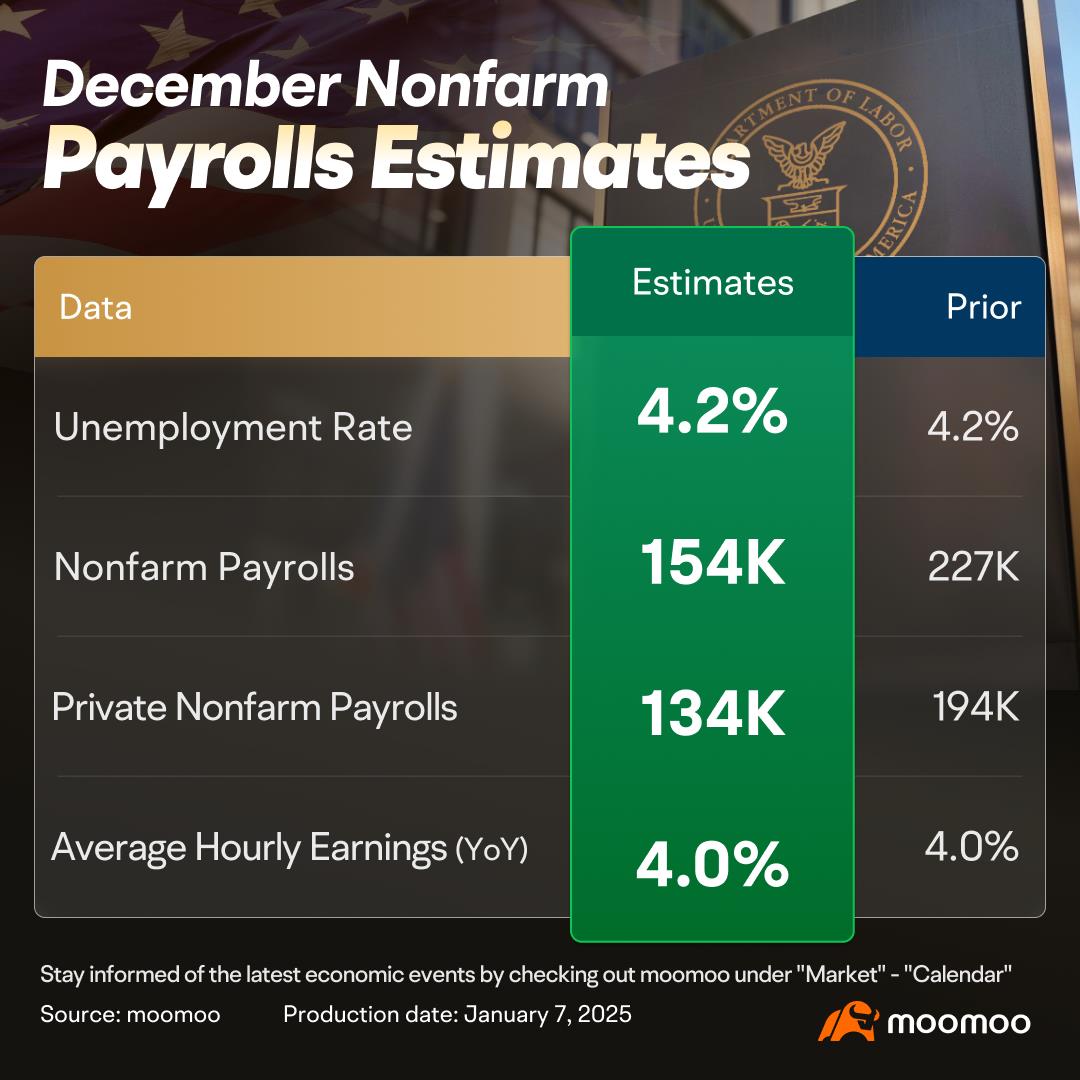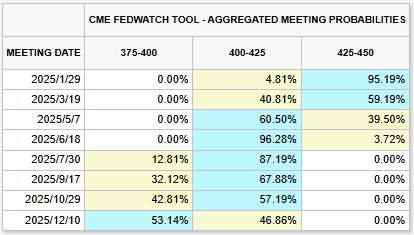December US Nonfarm Payrolls Preview | Economic Data May Boost Asset Volatility
December nonfarm payrolls report will be released at 8:30 a.m. ET this Friday. The median forecast of analysts for the upcoming nonfarm employment is 154K, downfrom 227K in November. The unemployment rate is expected to remain at 4.2%.

Benefiting from the dissipation of the negative impacts of hurricanes and strikes, the November US nonfarm payrolls data indicated a robust growth in the labor market. The US Bureau of Labor Statistics announced that the US added 227,000 new nonfarm jobs in November. It is worth noting that the unemployment rate rose to 4.246% in November, approaching the year's highest point of 4.253% in July.
The December nonfarm data is the first report in several months that is not affected by one-time factors. The October data was negatively impacted by hurricanes and the Boeing strike, while the November data saw a reversal due to the favorable base effect from October. The December report should provide a clearer picture of the current dynamics in the US labor market.
UBS expects that:
The December increase in US employment will be close to the recent moving average and continue to show a gradual cooling of the labor market. Given current market pricing, strong labor data is unlikely to lead the Federal Reserve to further interest rate cuts.
ING Bank expects that:
Labor market not to deteriorate rapidly but to worsen gradually, which is consistent with the Federal Reserve's cautious approach to easing policy. After the hawkish tilt in the December dot plot, a January rate cut would indeed require a series of data that sounds like a recession.
Fed Rate Cut Expectations Ease, Boosting Asset Volatility
The US December ISM services index rebounded to 54.1 on Tuesday, exceeding expectations, with the price index reaching a new high since early 2023, indicating a significant increase in cost pressures in the service sector and highlighting inflationary threats. In November, the US JOLTS job openings reached 8.098 million, surpassing the 8 million mark, and with the Federal Reserve's rate cuts anticipated for 2024, the JOLTS data significantly exceeded expectations, hitting a six-month high.
Both the ISM and JOLTS data exceeded expectations, suggesting that the US job market seems to be in a better state. Coupled with market concerns about persistent inflation, this has diminished expectations for rate cuts in 2025.
At the December FOMC meeting, Federal Reserve Chairman Powell indicated that the US labor market is cooling, but it is doing so gradually and in an orderly fashion, hinting that the Fed's focus has solidly returned to inflation.
According to the CME FedWatch tool, as of January 29, 2025, the probability of a 25 basis point rate cut at the Fed's first FOMC meeting is only 4.8%, while the probability of maintaining the interest rate unchanged at 4.25%-4.5% is 95.2%, higher than Monday's 91.4% and 62.9% a month ago.This Friday, the US will release the highly anticipated December nonfarm payrolls report, which will be one of the significant factors influencing the Fed's rate cuts in 2025.

Diminished expectations for Federal Reserve rate cuts have led to increased volatility in major asset classes, with US Treasury yields soaring. $U.S. 10-Year Treasury Notes Yield (US10Y.BD)$ climbed to 4.687%, reaching its highest level since April 25. On Tuesday, the three major US stock indexes declined, with $S&P 500 Index (.SPX.US)$ down 1.11%, $Dow Jones Industrial Average (.DJI.US)$ down 1.89%, and down 0.42%. Technology stocks were the biggest losers, with $Tesla (TSLA.US)$ falling over 4% and $NVIDIA (NVDA.US)$ dropping over 6%. $XAU/USD (XAUUSD.CFD)$ pulled back but eventually closed up 0.49%, and $USD (USDindex.FX)$ rebounded, closing up 0.42%.
The primary focus in the US stock market is currently on interest rate cuts rather than a recession. The release of the December nonfarm payrolls data has become a factor affecting the Federal Reserve's interest rate decisions, further intensifying the volatility of US stocks. The waning expectations for rate cuts will put pressure on risk assets across the board. As the 10-year Treasury yield continues to rise, it has already put pressure on US stock valuations. The correlation between the S&P 500 and bond yields has turned "significantly negative," and US stocks may face serious challenges in the future.
Citi analysts believe that job growth will slow to 120,000 in December, down from 227,000 in November, and they expect the unemployment rate to rise from 4.2% in November to 4.4%. If the December unemployment rate rises more than expected, the yield on the 10-year Treasury note could fall, which may alleviate the current high interest rate pressure and mitigate the impact on U.S. stocks.
What Else to Watch Besides Labor Data?
Donald Trump is set to be inaugurated on January 20th, and his policies following the takeover will be a significant factor affecting the volatility of the U.S. stock market. He regards stock market performance as a crucial measure of his administration's success. Trump's policies, which include substantial corporate tax cuts and the easing of financial regulations, may further stimulate the U.S. stock market, especially benefiting bank stocks, small-cap stocks, and cyclical stocks, as well as stocks that stand to gain from the "Trump concept".
The U.S. earnings season will gradually begin in mid-January and will also be a significant factor affecting the volatility of the U.S. stock market. The outstanding stock performance of U.S. tech giants in 2024 raised Wall Street's expectations; the question is whether they can prove themselves in the new earnings season.
The Federal Reserve's first interest rate decision meeting of 2025 will take place on January 28th and 29th, with the rate decision to be announced on January 29th. This meeting will set the tone for the Fed's interest rate cut pace in 2025. The market widely anticipates that the Fed will not decide on an interest rate cut at this meeting, and the first potential timing for a rate cut this year could be in March.
Source: Bloomberg, CME Group
Disclaimer: Moomoo Technologies Inc. is providing this content for information and educational use only.
Read more
Comment
Sign in to post a comment

73057226 : At this point at this point we could use any bit of help to get this market back up to the deposit could you believe what happened to $SPDR S&P 500 ETF (SPY.US)$ insane !! I was really hoping for to go back up but it just took down
Buy n Die Together❤ :
NSIKAN DICKSON :![undefined [undefined]](https://static.moomoo.com/nnq/emoji/static/image/default/default-black.png?imageMogr2/thumbnail/36x36)
justmuhd03 : buying
102701962 : they gonna hand a depressed stock market to Trump. Buying the Jan 21 Trump Dip!